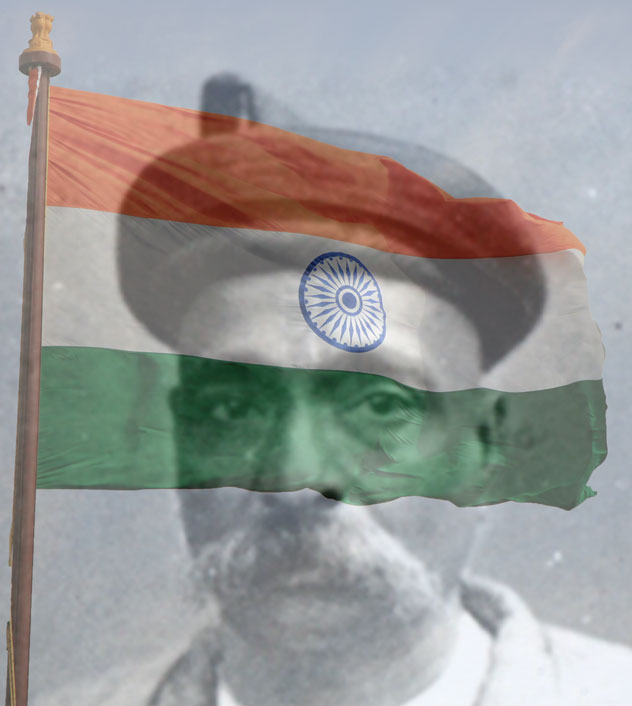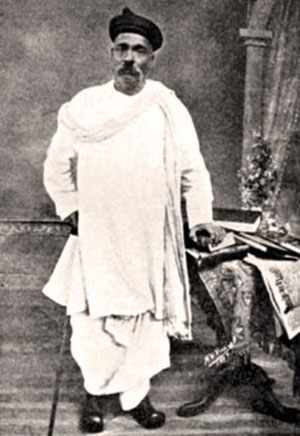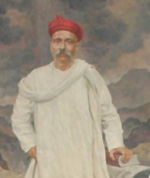COVER STORY:
Swaraj is My Birth Right: Lokmanya Bal Gangadhar Tilak
Siliconeer presents a special essay in remembrance of those responsible for India’s independence. This year we take you through the life of Lokmanya Bal Gangadhar Tilak, who was one of the first advocates of self-rule in India.
Born as Keshav Bal Gangadhar Tilak on July 23, 1856, in a village near Ratnagiri, Maharashtra, Lokmanya Bal Gangadhar Tilak was an Indian nationalist, teacher, social reformer, lawyer and independence fighter, who was the first popular leader of the Indian Independence Movement and was conferred with the honorary title of “Lokmanya.”

(Above): Lokmanya Bal Gangadhar Tilak [Photo: Wikimedia Commons]
Lokmanya Bal Gangadhar Tilak was one of the first and strongest advocates of Swaraj (self-rule) and a strong radical in Indian consciousness. His famous quote, “Swaraj is my birt right, and I shall have it!” is well remembered in India even today.
Coming from a father who was a schoolteacher and a Sanskrit scholar, young Tilak was a brilliant student who graduated from Deccan College in Pune in 1877. Tilak was among one of the first generation of Indians to receive a college education.
He took an active part in public affairs. “Religion and practical life are not different. To take sanyas (renunciation) is not to abandon life. The real spirit is to make the country, your family, work together instead of working only for your own. The step beyond is to serve humanity and the next step is to serve God,” he said.
This dedication to humanity was a fundamental element of the Indian Nationalist Movement.
After graduating, Tilak initially began teaching mathematics in a private school in Pune but gave it up due to ideological differences with colleagues and became a journalist.
He was a strong critic of the Western education system, feeling it demeaned the Indian students and disrespected India’s heritage.
He formed ‘Deccan Education Society’ with a few college friends, including Gopal Ganesh Agarkar, Mahadev Ballal Namjoshi and Vishnushastri Krushnashastri Chiplunkar, with a goal to improve the quality of education for India’s youth. The Deccan Education Society was set up to create a new system that taught young Indians nationalist ideas through an emphasis on Indian culture.
Tilak began a mass movement towards independence that was camouflaged by an emphasis on a religious and cultural revival.
 (Right): Lokmanya Bal Gangadhar Tilak [Photo: Wikimedia Commons] (Right): Lokmanya Bal Gangadhar Tilak [Photo: Wikimedia Commons]
Tilak joined the Indian National Congress in 1890. He opposed its moderate attitude, especially towards the fight for self-government. He was one of the most-eminent radicals at the time.
Despite being personally opposed to early marriage, Tilak opposed the 1891 Age of Consent bill that raised the age of marriage for a girl from 10 to 12 years, seeing it as an interference with Hinduism and a dangerous precedent.
In 1896, a plague epidemic spread from Mumbai to Pune, and by January 1897 it reached epidemic proportions. In order to suppress the epidemic and prevent its spread, a Special Plague Committee was appointed under W.C. Rand, I.C.S., Assistant Collector of Pune. Tilak took up the people’s cause by publishing inflammatory articles in his Marathi paper Kesari, quoting the Bhagavad Gita to say that no blame could be attached to anyone who killed an oppressor without any thought of reward.
Following this, on June 22, 1897, Rand and another British officer, Lt. Ayerst were shot and killed by the Chapekar brothers and their associates. Tilak was charged with incitement to murder and sentenced to 18 months imprisonment.
When he emerged from prison, he was revered as a martyr and a national hero. He adopted a new slogan, “Swaraj is my birthright and I shall have it.”
Following the partition of Bengal in 1905, which was a strategy set out by Lord Curzon to weaken the nationalist movement, Tilak encouraged the Swadeshi and Boycott movements.
The Boycott movement was aimed at a boycott of foreign goods and also the social boycott of any Indian who used foreign goods. The Swadeshi movement was aimed at usage of goods produced by self or in India. Once foreign goods were boycotted, there was a gap that had to be filled by the production of those goods in India itself. Tilak, therefore, rightly said that Swadeshi and Boycott movements are two sides of the same coin.
Tilak opposed the moderate views of Gopal Krishna Gokhale, and was supported by fellow Indian nationalists Bipin Chandra Pal in Bengal and Lala Lajpat Rai in Punjab. They were referred to as the Lal-Bal-Pal triumvirate.
 (Left): Lokmanya Bal Gangadhar Tilak [Photo: PIB] (Left): Lokmanya Bal Gangadhar Tilak [Photo: PIB]
In 1907, the annual session of the Congress Party was held in Surat, Gujarat. Trouble broke out between the moderate and the extremist factions of the party over the selection of the new president of the Congress. The party split into the Jahal Matavadi (hot faction or extremists), led by Tilak, Pal and Lajpat Rai, and the Maval Matavadi (soft faction or moderates). Nationalists like Aurobindo Ghose supported Tilak.
On April 30, 1908, two Bengali youths, Prafulla Chaki and Khudiram Bose, threw a bomb on a carriage at Muzzafarpur, trying to kill the Chief Presidency Magistrate Douglas Kingsford of Calcutta, but erroneously killed some women travelling in it. While Chaki committed suicide when caught, Bose was hanged. Tilak, in his paper Kesari, defended the revolutionaries and called for immediate Swaraj or self-rule.
The Government arrested him for sedition. A special jury convicted him, sentencing him to six years exile imprisonment and Rs. 1,000 fine.
Tilak was sent to Mandalay, Burma from 1908 to 1914. While imprisoned, he continued to read and write, further developing his ideas on the Indian Nationalist movement. While in the prison he wrote the famous Gita Rahasya. The book sold a lot of copies and the proceeds were donated to the cause of freedom fighting.
Tilak had mellowed after his release in June 1914, more because of the diabetes and hardship in Mandalay prison. When World War I started in August 1914, Tilak cabled the King-Emperor in Britain of his support and turned his oratory to find new recruits for war efforts. He welcomed The Indian Councils Act, popularly known as Minto-Morley Reforms, which had been passed by British Parliament in May 1909, terming it as “a marked increase of confidence between the Rulers and the Ruled.” Acts of violence actually retarded, than hastened the pace of political reforms, felt Tilak. He was eager for reconciliation with Congress and had abandoned his demand for direct action and settled for agitations “strictly by constitutional means” — a line advocated by his rival Gopal Krishna Gokhale.
Tilak saw the spark in Mohandas Gandhi and tried to convince Gandhi to give up “Total Ahimsa” and get “Swaraj” by all means. Gandhi looked upon him as his guru but did not change his mind.
Later, Tilak reunited with his fellow nationalists and rejoined the Indian National Congress in 1916. He also helped found the All India Home Rule League in 1916–18 with G.S. Khaparde, Muhammad Ali Jinnah and Annie Besant.
After years of trying to reunite the moderate and radical factions, he gave up and focused on the Home Rule League, which sought self-rule. Tilak traveled from village to village trying to conjure support from farmers and locals to join the movement towards self-rule.
Tilak, who started his political life as a Maratha propagandist, progressed into a prominent nationalist after his close association with Indian nationalists following the partition of Bengal.
When asked in Calcutta whether he envisioned a Maratha-type of government for Free India, Tilak replied that the Maratha-dominated governments of 17th. and 18th. centuries were outmoded in the 20th. century, and he wanted a genuine federal system for Free India where every religion and race was an equal partner. He added that only such a form of government would be able to safeguard India’s freedom.
He was the first Congress leader to suggest that Hindi written in the Devanagari script be accepted as the sole national language of India.
He said, “I regard India as my Motherland and my Goddess, the people in India my kith and kin, and loyal and steadfast work for their political and social emancipation my highest religion and duty.”
Tilak transformed household worshipping of Ganesha into Sarvajanik Ganeshotsav in 1894.
In 2007, the Government of India released a coin to commemorate the 150th birth anniversary of Bal Gangadhar Tilak.
|